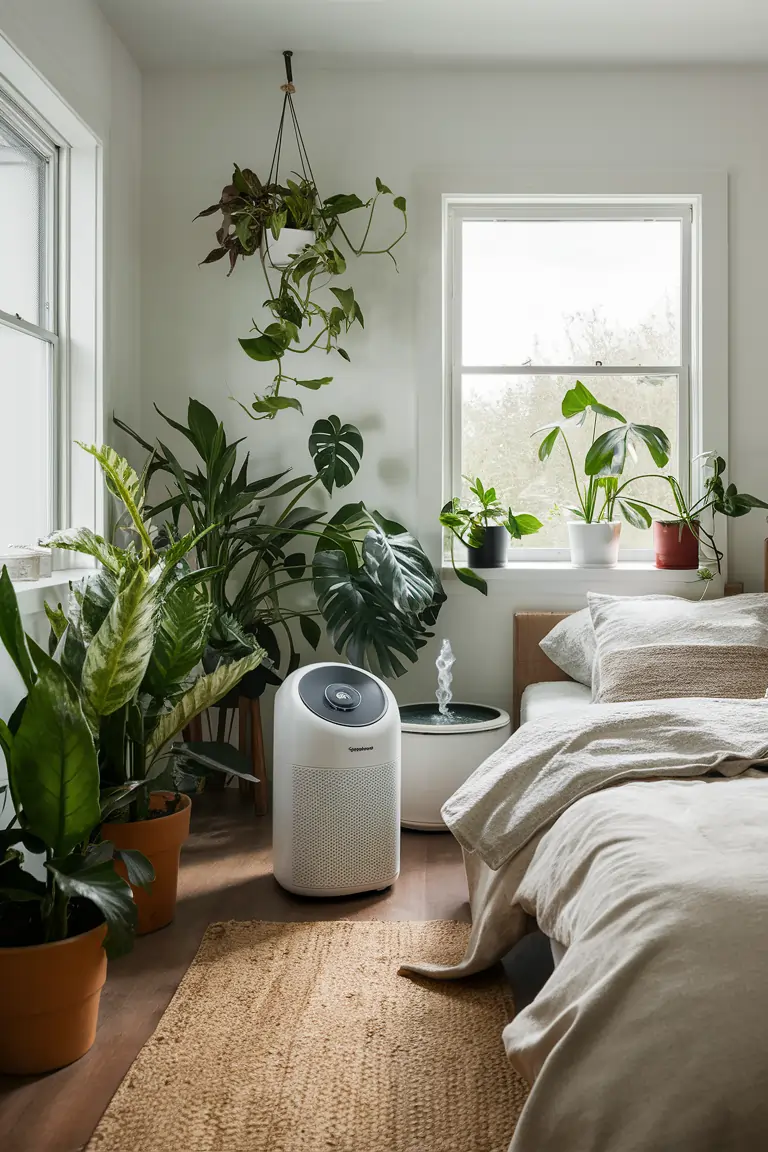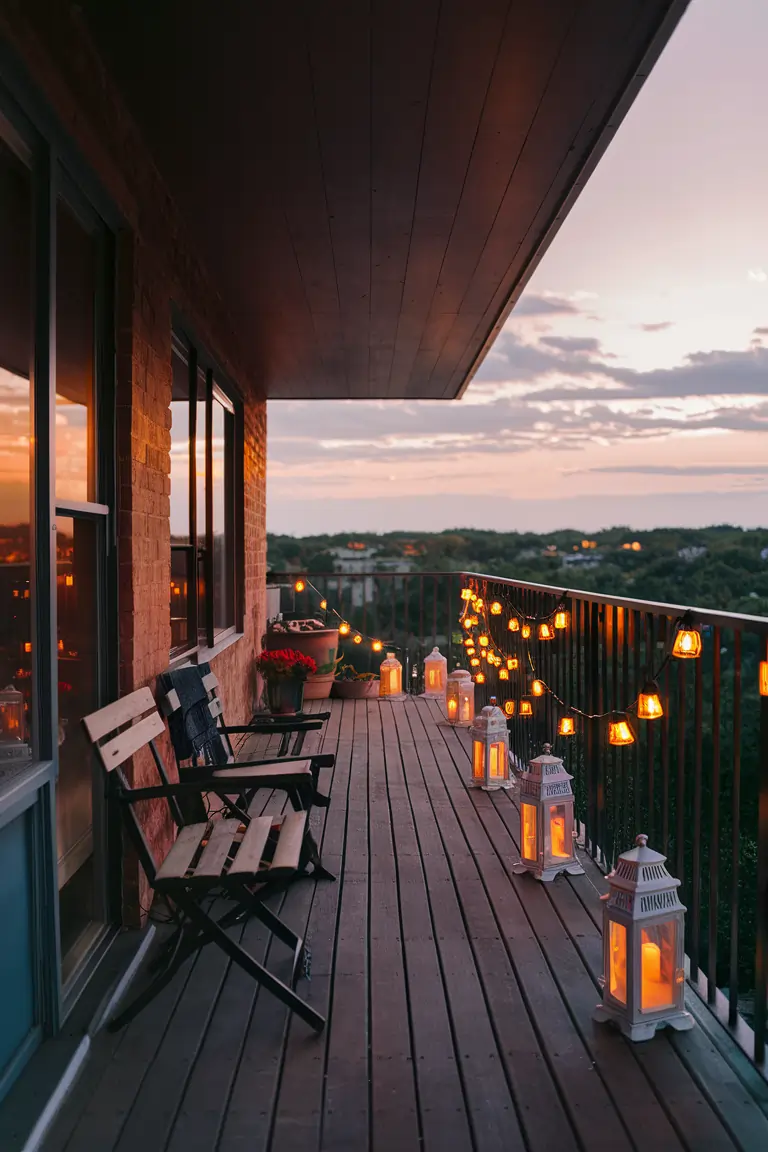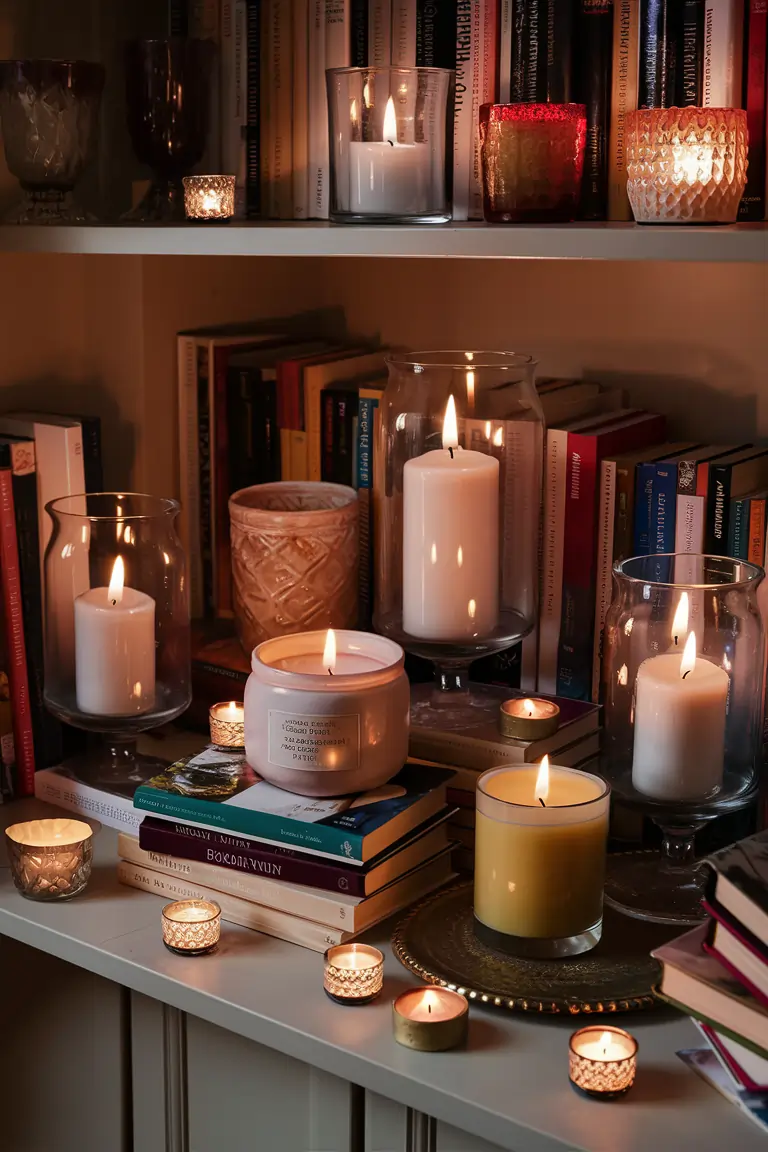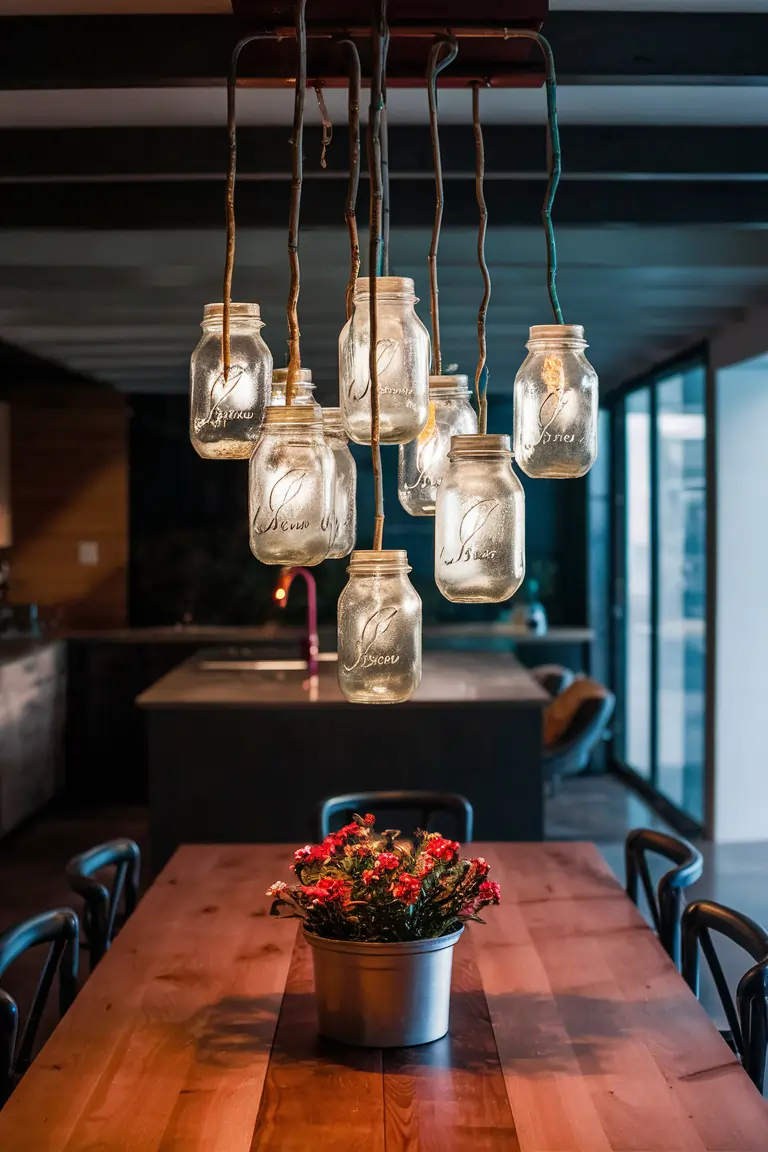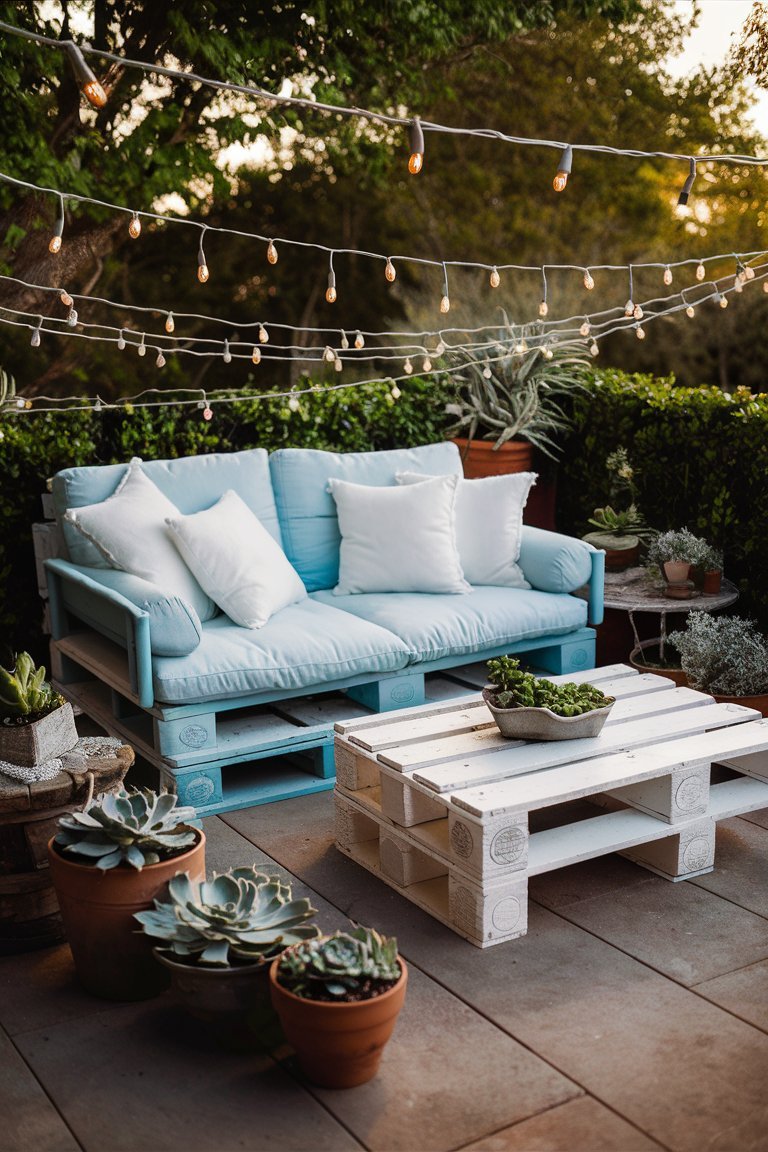20 Relaxing Bedroom Ideas for Creating Your Perfect Cozy Retreat
Your bedroom should be more than just a place to sleep—it should be your personal sanctuary, a peaceful retreat from the chaos of daily life. Creating a relaxing bedroom environment is essential for both mental well-being and quality rest.
In this comprehensive guide, we’ll explore 20 thoughtfully curated bedroom ideas that combine comfort, style, and tranquility. From color schemes to lighting solutions, these ideas will help you transform your bedroom into the cozy haven you deserve.
Whether you’re planning a complete renovation or looking for simple updates, these suggestions will inspire you to create your perfect peaceful space.
1. Calming Color Palette

The foundation of any relaxing bedroom starts with the right color scheme. Soft, muted tones create a serene atmosphere that naturally promotes relaxation. Consider painting your walls in gentle shades of blue, which studies show can lower heart rate and blood pressure. Alternatively, warm greiges (gray-beige), soft sage greens, or pale lavender can create a peaceful backdrop.
Avoid bright, energetic colors that might disrupt sleep. Layer these wall colors with complementary bedding and curtains in similar tones for a cohesive look. Add depth with subtle variations of your chosen color through textiles and accessories. Remember to test paint samples at different times of day to ensure the color maintains its calming effect in various lighting conditions.
Image prompt: A serene bedroom with walls painted in soft blue-gray, featuring layers of textiles in complementary muted tones, with natural light filtering through sheer curtains.
2. Luxurious Layered Bedding
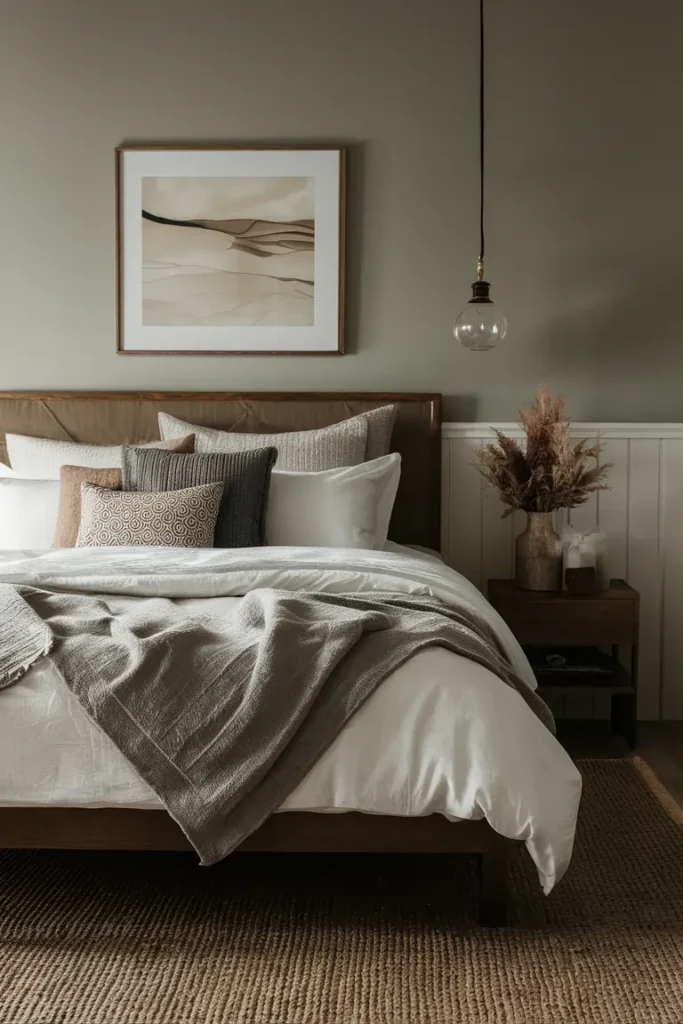
Transform your bed into an inviting retreat with thoughtfully layered bedding that appeals to both sight and touch. Start with high-quality sheets in natural fibers like cotton or linen, known for their breathability and softness. Add a medium-weight duvet or comforter in a neutral tone, then layer with a quilted coverlet or throw blanket for added texture and warmth. Include at least four sleeping pillows in varying firmness levels, decorated with two to three accent pillows in coordinating colors and textures. Consider adding a soft throw at the foot of the bed for easy access during afternoon naps. Choose materials that feel good against your skin and are appropriate for your local climate.
3. Ambient Lighting Design
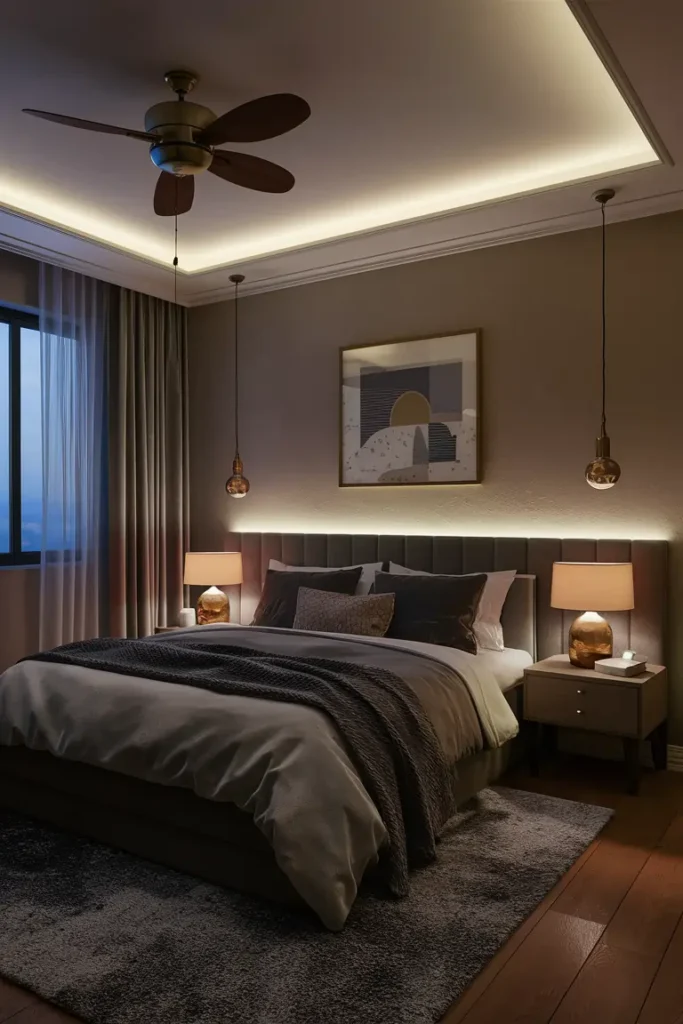
Create a peaceful atmosphere with a well-planned lighting scheme that can be adjusted throughout the day. Install dimmer switches on overhead fixtures to control light levels, and incorporate multiple light sources at different heights. Place matching table lamps on bedside tables for symmetry and functional reading light. Add soft uplighting in corners or behind furniture for a gentle glow. Consider installing LED strip lighting under bed frames or behind headboards for subtle ambient light. Wall sconces mounted at the proper height for reading can eliminate bedside table clutter. Choose warm-toned bulbs (2700-3000K) to promote relaxation and maintain healthy circadian rhythms.
4. Natural Elements
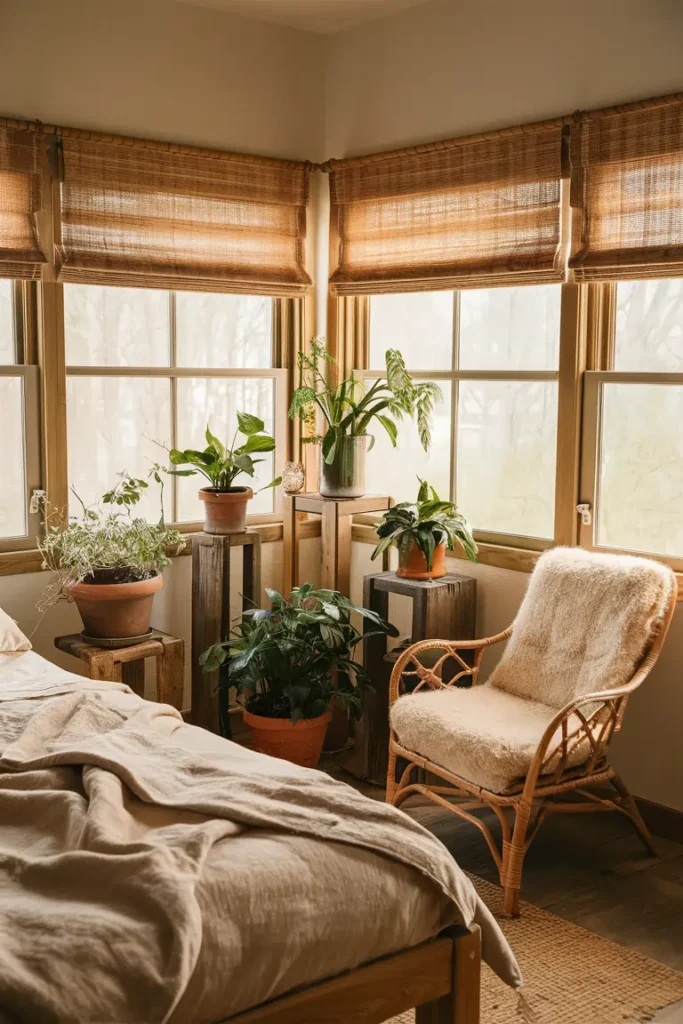
Incorporate elements from nature to create a grounding, peaceful environment in your bedroom. Include potted plants like snake plants or peace lilies that thrive in bedroom conditions and help purify the air. Use natural materials such as wooden furniture pieces, bamboo blinds, or a rattan accent chair. Add a small indoor water feature for gentle, soothing sounds. Display collections of stones, shells, or crystals on nightstands or dressers. Choose organic shapes in artwork and accessories. Consider adding a small herb garden on your windowsill with calming varieties like lavender or chamomile. These natural elements help create a connection to the outdoors and promote a sense of calm.
5. Minimalist Organization
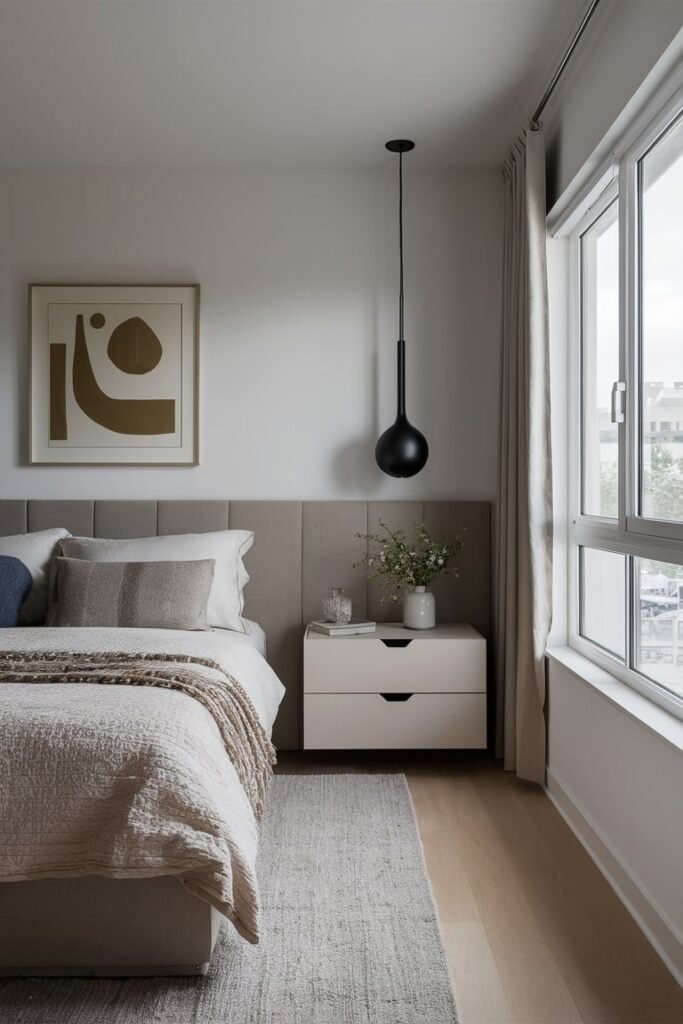
Create a peaceful environment by embracing minimalist organization principles in your bedroom. Install custom closet solutions to keep clothing and accessories neatly stored and out of sight. Use under-bed storage containers for seasonal items, choosing options that slide easily and remain hidden. Implement a nightstand with drawers to conceal personal items while maintaining easy access. Consider floating shelves for decorative items to keep floor space clear. Choose furniture with clean lines and hidden storage options. Maintain a clutter-free surface policy, allowing only essential items to remain visible. This organized approach helps reduce visual noise and promote mental clarity.
6. Cozy Reading Nook
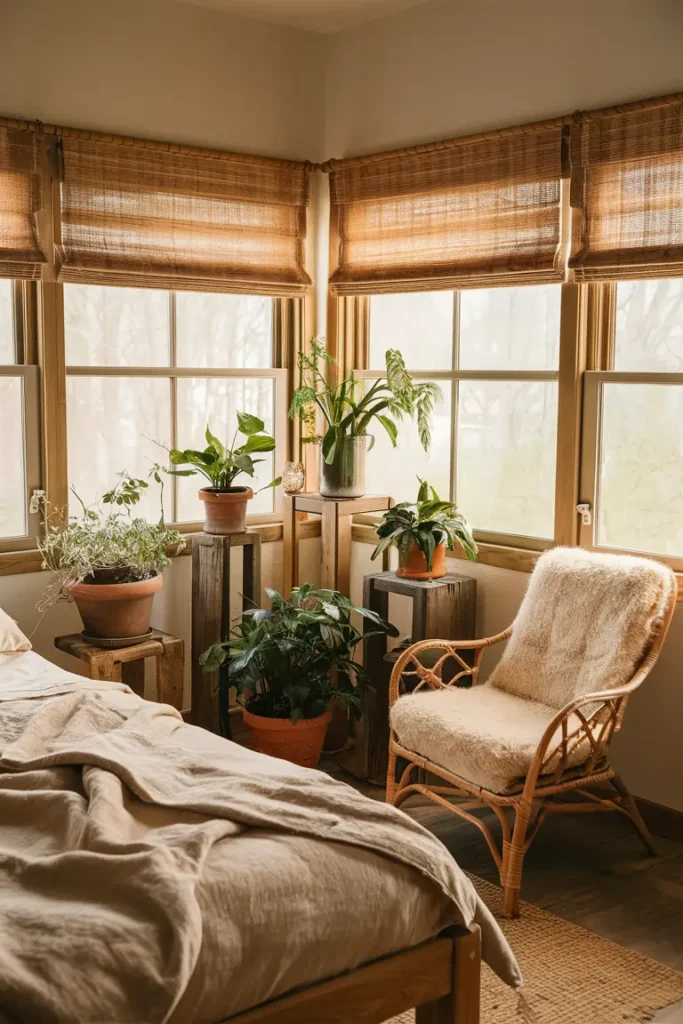
Designate a comfortable corner of your bedroom for a personal reading retreat. Start with a plush armchair or chaise lounge in a soft, durable fabric. Add a small side table for beverages and books, and position an adjustable reading lamp nearby for proper lighting. Layer the space with a soft throw blanket and a lumbar pillow for extra comfort. Consider installing a floating shelf above for favorite books or a small bookcase nearby. Place a soft area rug under the seating area to define the space and add warmth underfoot. This dedicated relaxation space provides a peaceful spot for unwinding with a good book before bed.
7. Blackout Window Treatments
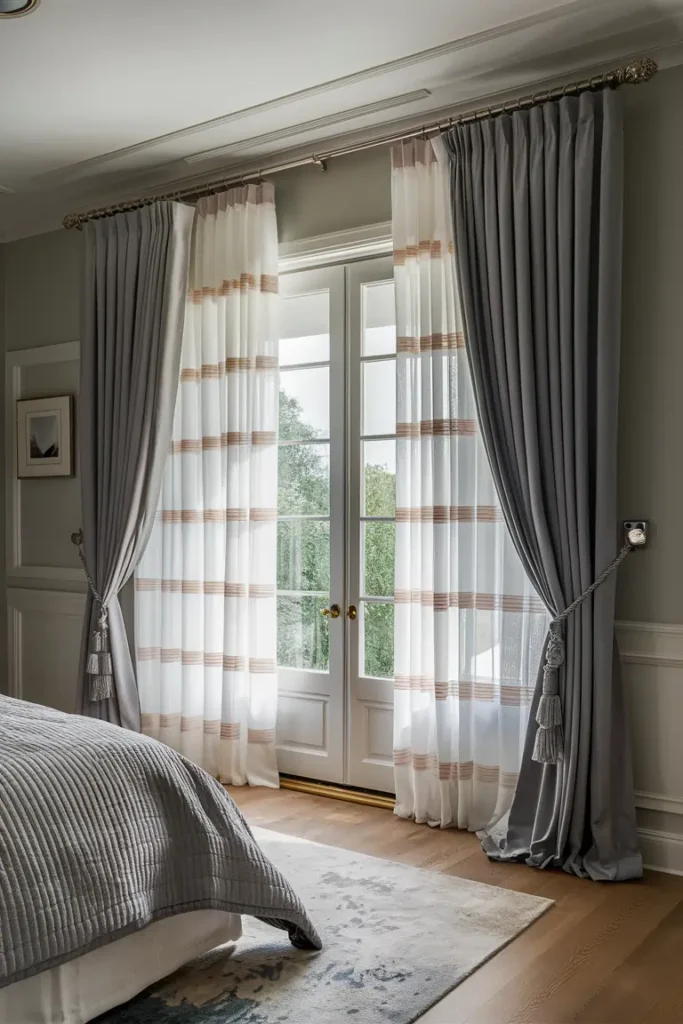
Create the perfect sleep environment with effective window treatments that block out unwanted light. Layer your window coverings for both functionality and style. Install blackout curtains or cellular shades in colors that complement your room’s palette. Consider double-rod systems that allow for both sheer privacy curtains and heavier blackout panels. Choose curtains that extend beyond the window frame to minimize light leakage. Add decorative curtain tiebacks or automated controls for easy adjustment. These window treatments not only improve sleep quality but also help regulate room temperature and reduce outside noise, contributing to a more peaceful environment.
8. Sound Management Solutions

Transform your bedroom into a quiet sanctuary with effective sound management techniques. Install sound-absorbing materials like thick carpet, area rugs, or acoustic panels disguised as artwork. Use upholstered headboards and soft furnishings to reduce sound reflection. Consider adding white noise machines or small water features to mask disruptive sounds. Place rubber pads under furniture legs to prevent noise from movement. Install door sweeps and weather stripping to block hallway noise. Position furniture strategically to create sound barriers from exterior walls. These solutions work together to create a peaceful acoustic environment conducive to relaxation and restful sleep.
9. Aromatherapy Integration
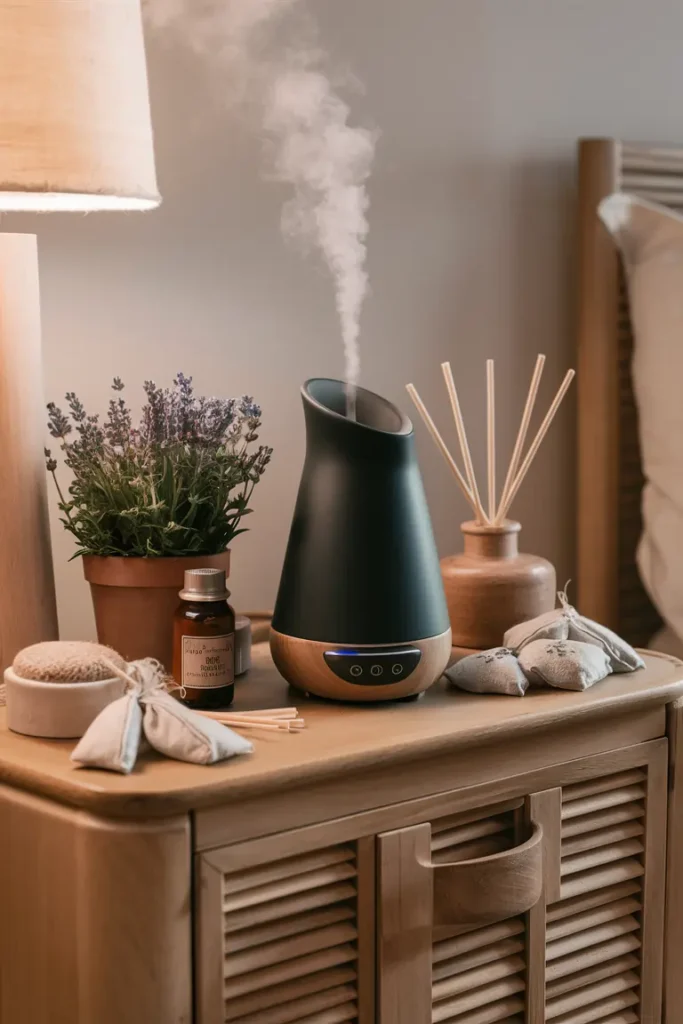
Enhance your bedroom’s relaxing atmosphere with thoughtfully integrated aromatherapy elements. Install an essential oil diffuser on your nightstand or dresser, using calming scents like lavender, chamomile, or vanilla. Create sachets with dried herbs to place in drawers and closets. Consider adding naturally fragrant plants like jasmine or gardenia. Use linen sprays with gentle scents on bedding. Place reed diffusers in strategic locations for consistent fragrance. Choose natural, chemical-free options to avoid overwhelming the space. These aromatic additions help create a multi-sensory relaxation experience and can promote better sleep quality.
10. Zen-Inspired Simplicity

Embrace the principles of Zen design to create a truly peaceful bedroom retreat. Focus on clean lines and uncluttered spaces, using a minimalist approach to furniture and decor. Choose low-profile furniture pieces in natural wood tones. Incorporate elements of asymmetrical balance through simple artwork or a single striking plant. Use natural textures like bamboo, rice paper, or stone. Keep color schemes monochromatic or limited to two complementary tones. Remove unnecessary technology and maintain clear pathways through the room. This simplified approach helps create a space that promotes mental clarity and relaxation.
11. Soft Textile Layers
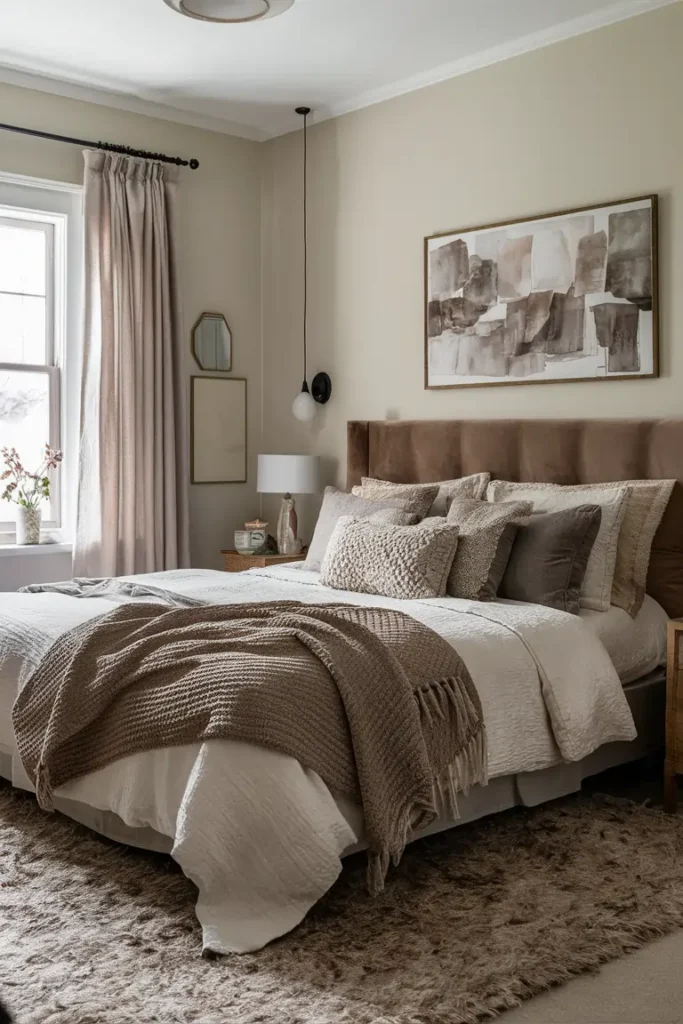
Create depth and comfort through thoughtfully layered textiles throughout your bedroom. Start with a plush area rug under the bed, extending generously on all sides for soft stepping surfaces. Layer window treatments with both sheers and heavier drapes in complementary textures. Add upholstered elements like a padded headboard or bench in soft, tactile fabrics. Include multiple throw pillows in varying sizes and textures, from smooth velvet to nubby linen. Drape soft throws over seating areas and bed corners. Choose materials that invite touch and create visual interest while maintaining a cohesive color scheme.
12. Personal Art Gallery
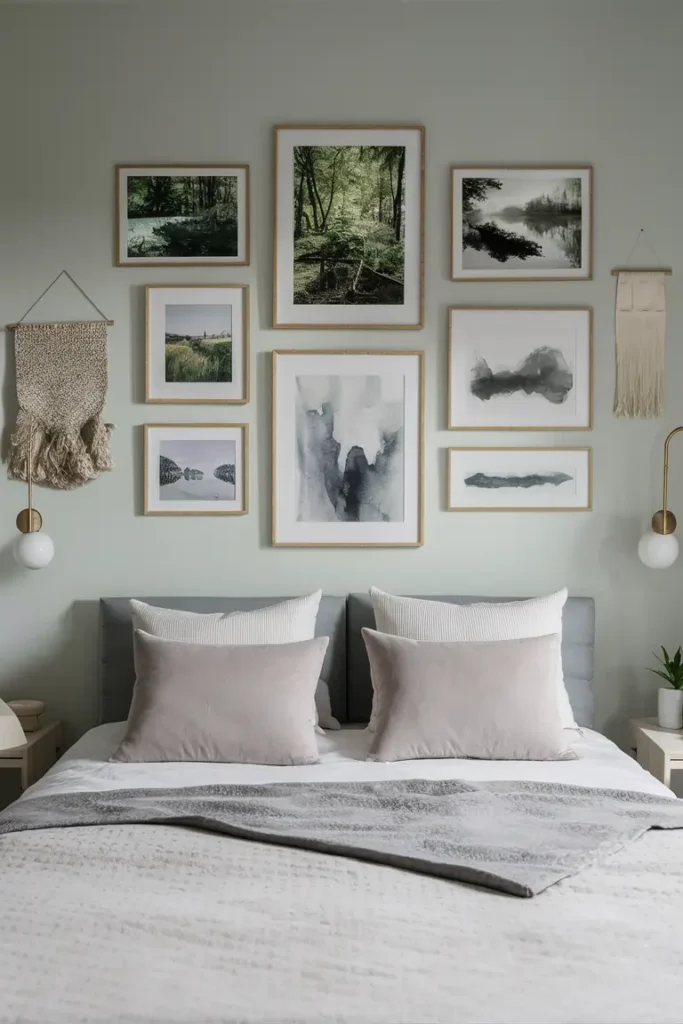
Transform your bedroom walls into a curated collection of calming artwork that speaks to your soul. Choose pieces with soothing subjects like nature scenes, abstract landscapes, or soft color studies. Create a gallery wall using matching frames for cohesion, or select one large statement piece for impact. Consider incorporating personal photographs printed in black and white or sepia tones. Add dimensional elements like woven wall hangings or sculptural pieces. Position artwork at eye level when standing and sitting for optimal viewing. Select pieces that promote relaxation and positive emotions while avoiding busy or energetic compositions.
13. Temperature Control Solutions
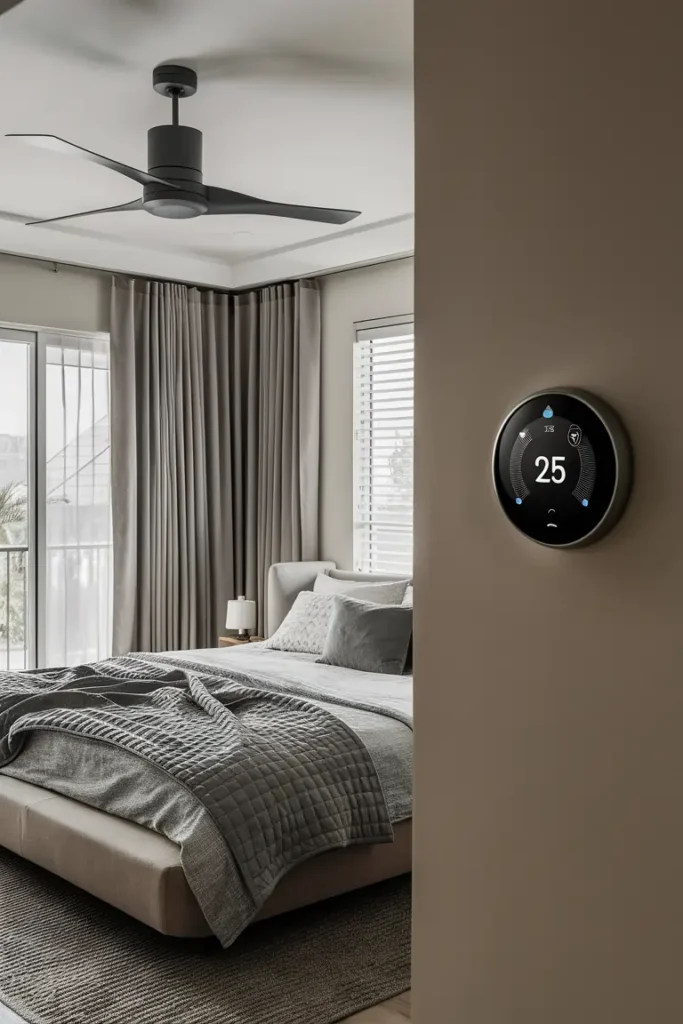
Create the perfect sleep environment by implementing effective temperature control solutions. Install programmable thermostats to automatically adjust room temperature for optimal sleeping conditions. Use ceiling fans with reversible motors for year-round comfort. Add thermal curtains to regulate temperature from windows. Consider weighted blankets with cooling or warming properties. Place portable fans or heaters strategically for targeted comfort. Use mattress toppers or covers designed for temperature regulation. Include humidity control through dehumidifiers or humidifiers as needed. These solutions work together to maintain the ideal sleep temperature range of 60-67 degrees Fahrenheit.
14. Meditation Space
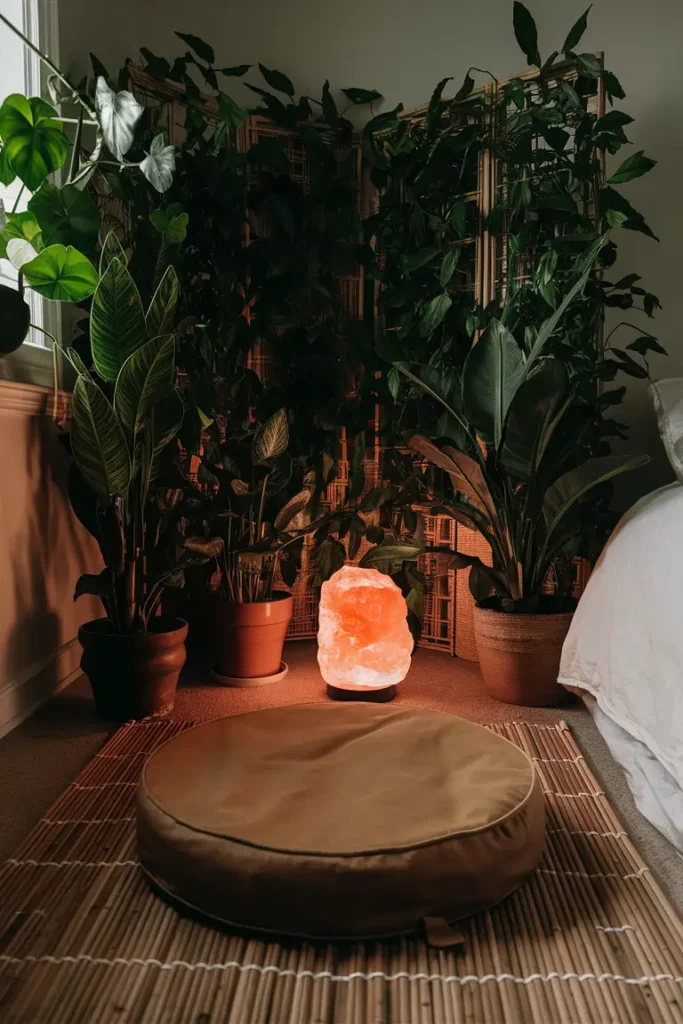
Designate a peaceful corner of your bedroom for meditation and mindfulness practices. Create a comfortable seating area with floor cushions, a meditation pillow, or a small yoga mat. Add soft lighting through candles or a Himalayan salt lamp. Include storage for meditation accessories like mala beads or singing bowls. Position inspiring artwork or meaningful objects within view. Use room dividers or plants to create a sense of privacy. Keep the space minimal and free from distractions. This dedicated area provides a perfect spot for morning meditation or evening relaxation practices.
15. Smart Lighting Control
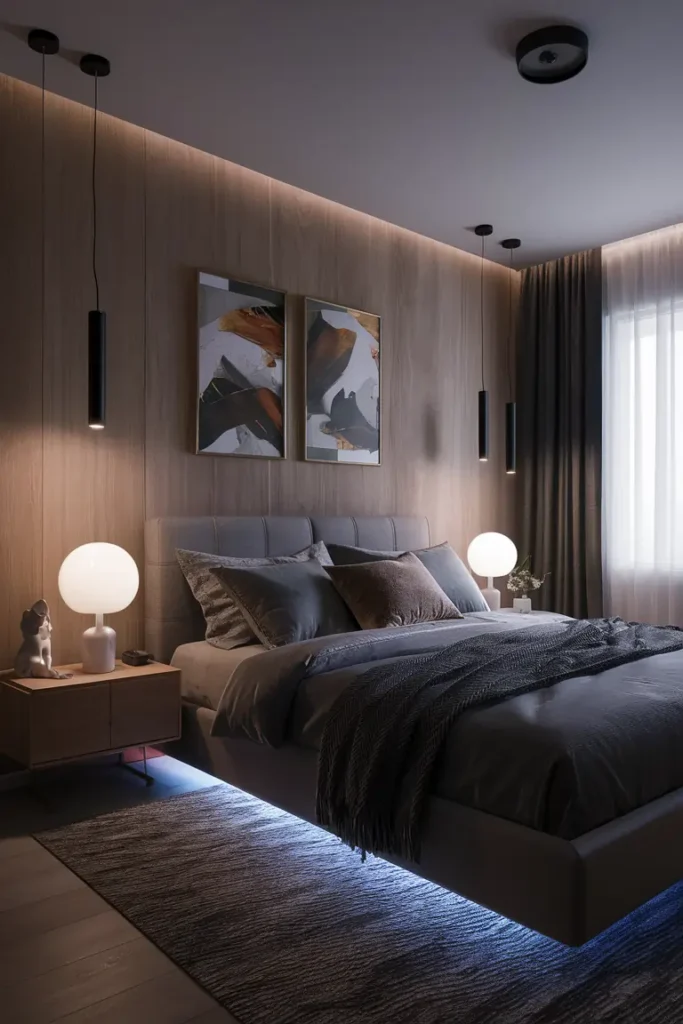
Implement smart lighting solutions for ultimate control over your bedroom’s ambiance. Install smart bulbs that can be dimmed and color-adjusted through smartphone apps or voice commands. Program lighting scenes for different activities like reading, relaxing, or waking up. Add motion-activated under-bed lighting for nighttime navigation. Include smart plugs for automatic control of lamps and other lighting fixtures. Consider natural wake-up lights that simulate sunrise for gentle morning transitions. These technological solutions help maintain proper circadian rhythms while providing convenient control over your bedroom’s atmosphere.
16. Bedside Organization
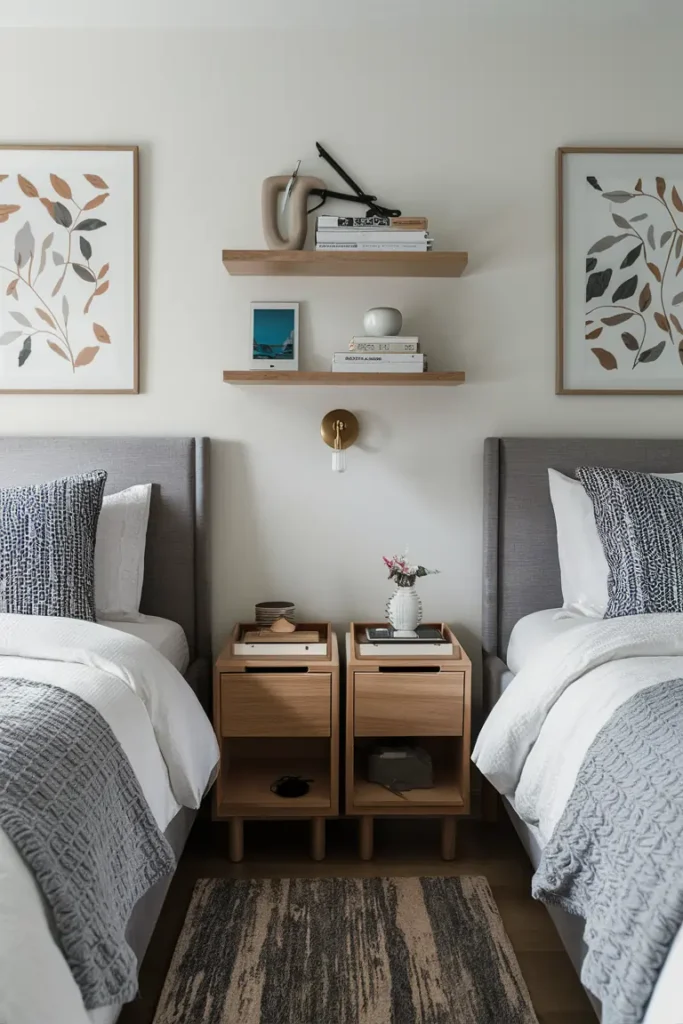
Create functional and aesthetically pleasing bedside spaces that promote relaxation while keeping essentials within reach. Choose nightstands with both drawer and surface space for versatile storage. Use attractive trays or dishes to corral small items like reading glasses or jewelry. Install floating shelves above nightstands for additional storage without bulk. Include charging stations for electronics, neatly concealed. Add small bins or baskets for books and magazines. Keep surfaces clean with only essential items displayed. Consider matching bedside tables for visual balance, each equipped with task lighting and storage solutions.
17. Air Quality Enhancement

Optimize your bedroom’s air quality for better sleep and overall wellness. Incorporate air-purifying plants like spider plants or Boston ferns. Install high-quality air filters or air purifiers with HEPA technology. Use natural cleaning products and bedding materials to reduce chemical exposure. Consider adding a small indoor fountain for humidity balance. Keep windows accessible for regular fresh air circulation. Choose low-VOC paints and materials for any renovations. These elements work together to create a clean, healthy sleeping environment that promotes relaxation and respiratory comfort.
18. Ergonomic Furniture Selection
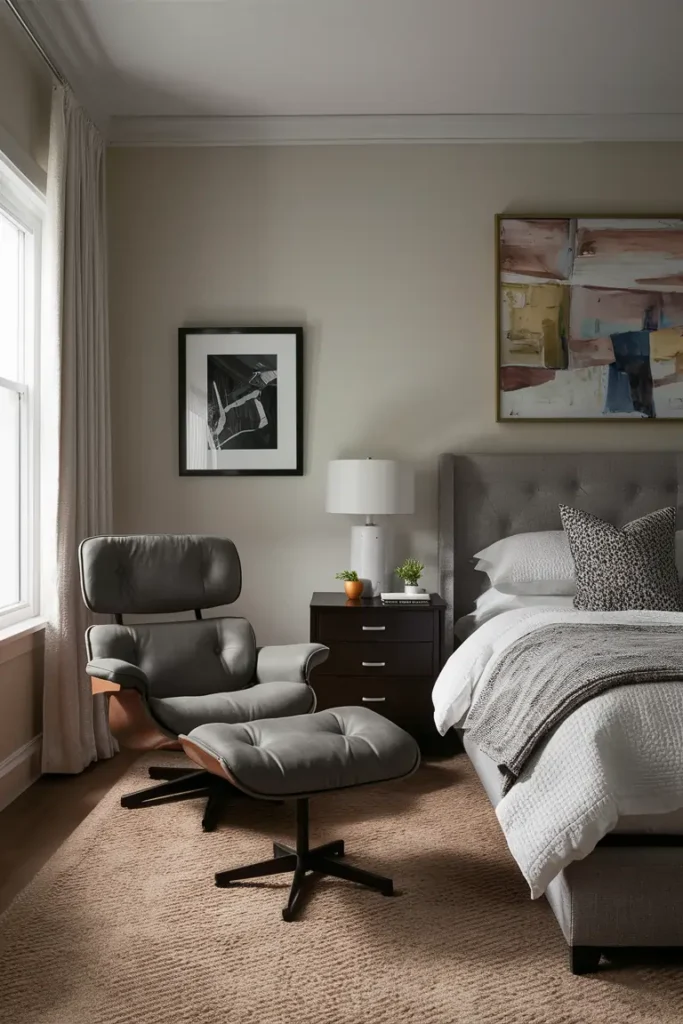
Choose bedroom furniture that supports proper posture and comfort for various activities. Start with a supportive mattress and adjustable bed base if possible. Include ergonomic seating options like a proper reading chair with lumbar support. Position furniture at comfortable heights for daily activities. Add ottoman or footrest options for elevated foot support. Consider adjustable-height bedside tables or wall-mounted options. Include proper support for technology use, such as laptop stands or tablet holders. These thoughtful furniture choices help prevent strain and promote relaxation during all bedroom activities.
19. Creative Storage Solutions

Maximize relaxation by minimizing visual clutter through innovative storage solutions. Install built-in wardrobes or closet systems that extend to the ceiling. Use vacuum storage bags for seasonal items under the bed. Add ottoman storage for extra blankets and pillows. Incorporate multi-functional furniture like storage benches or headboards with hidden compartments. Install pull-out organizers in existing furniture. Use vertical space with wall-mounted storage systems. These solutions help maintain a clean, organized space while keeping necessary items easily accessible.
20. Seasonal Adaptability
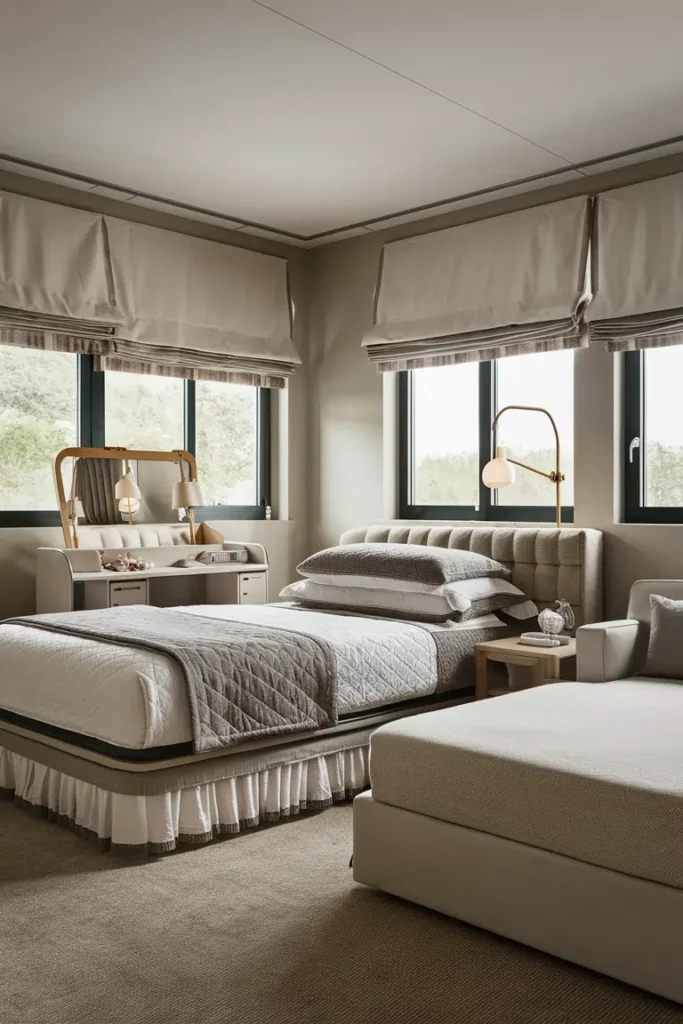
Design your bedroom to easily transition between seasons for year-round comfort. Include storage solutions for rotating seasonal bedding and decor. Use layered window treatments that can be adjusted for different light and temperature needs. Choose versatile furniture pieces that work well in all seasons. Include fans and heating options that can be easily accessed or concealed. Select bedding in materials appropriate for temperature changes. Add or remove textile layers seasonally for comfort and style. This adaptability ensures your bedroom remains a cozy retreat throughout the year.
Conclusion
Creating a relaxing bedroom retreat is an investment in your well-being and quality of life. By implementing these 20 ideas, you can transform your bedroom into a peaceful sanctuary that promotes rest, relaxation, and rejuvenation. Remember that creating your perfect space is a personal journey—choose the elements that resonate most with your lifestyle and preferences. Focus on incorporating changes

